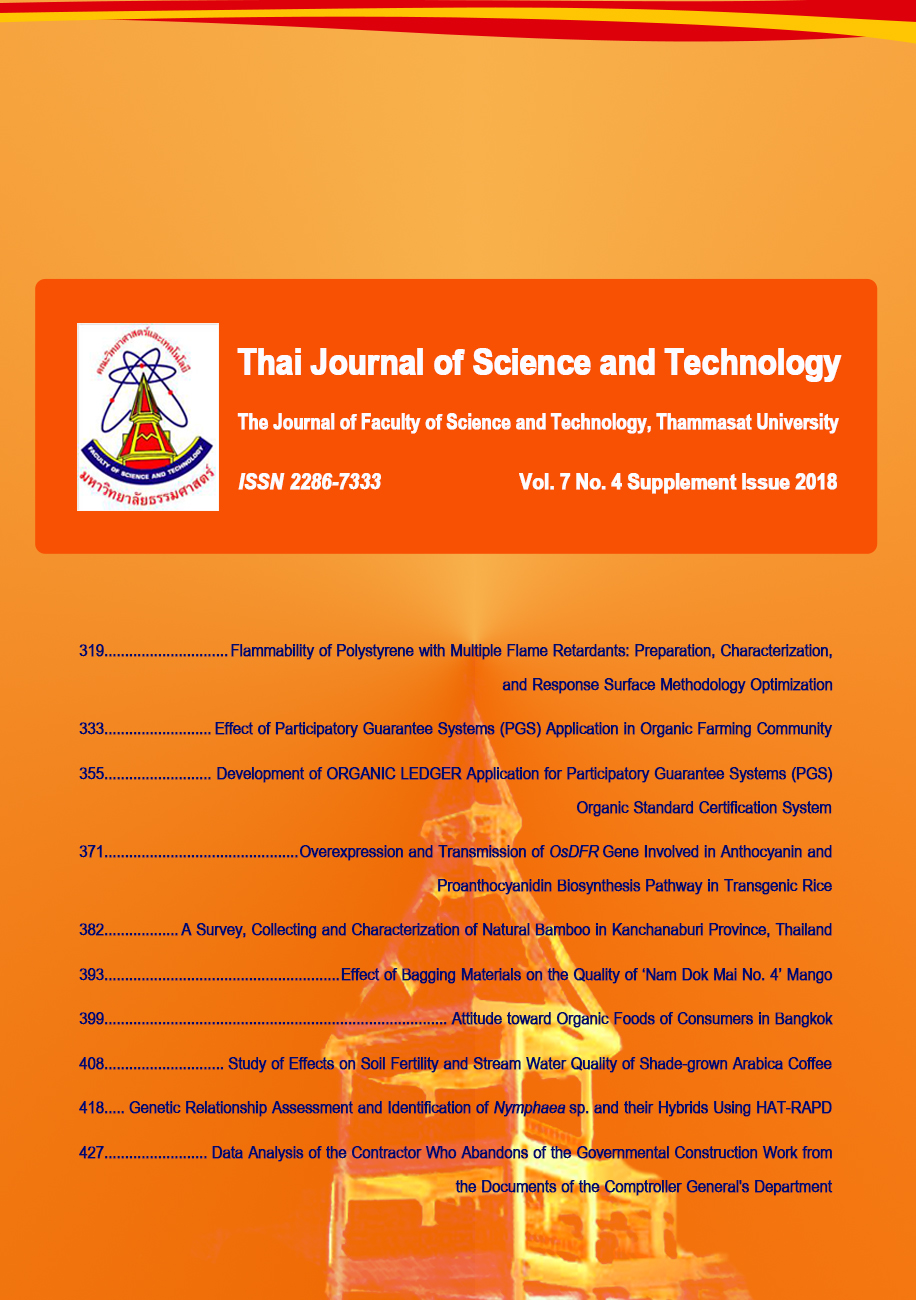การเพิ่มการแสดงออกและการถ่ายทอดยีน OsDFR ที่เกี่ยวข้องในวิถีการสังเคราะห์แอนโทไซยานินและโปรแอนโทไซยานิดินในข้าวดัดแปลงพันธุกรรม
Main Article Content
Abstract
บทคัดย่อ
ยีน OsDFR ซึ่งมีรหัสสร้างเอนไซม์ dihydroflavonol 4-reductase (DFR) เป็นยีนโครงสร้างที่สำคัญในวิถีการสังเคราะห์แอนโทไซยานินและโปรแอนโทไซยานิดิน งานวิจัยนี้ได้โคลนยีนและศึกษาหน้าที่ของยีน OsDFR ที่มีต่อการสังเคราะห์สีของเยื่อหุ้มเมล็ดในข้าวไทย โดยการโคลนยีน OsDFR จากข้าวดำพันธุ์ก่ำ และสร้างชุดยีนให้อยู่ภายใต้การควบคุมของ dual 35S promoter และ nos terminator แล้วถ่ายยีนเข้าสู่ข้าวแดงพันธุ์ Kasalath พบว่าแคลลัสมีการเจริญเติบโตเกิดจุดเขียวและพัฒนาเป็นต้น เมื่อนำต้นข้าวที่ได้รับการถ่ายยีนมาตรวจสอบยีน OsDFR ด้วยเทคนิคพีซีอาร์ พบว่าให้ผลเป็นบวก 77.78 เปอร์เซ็นต์ การทดสอบการกระจายตัวของยีน gusA และยีน OsDFR ในข้าวดัดแปลงพันธุกรรม พบว่ามีการถ่ายทอดของยีนไปสู่รุ่นลูก T1 เป็นไปตามกฎของเมนเดล คือ อัตราส่วน 3 : 1 แสดงว่ามีการแทรกของยีนเข้าไปหนึ่งตำแหน่งในจีโนมข้าว นอกจากนี้การวิเคราะห์การแสดงออกของยีนในเนื้อเยื่อใบของข้าวดัดแปลงพันธุกรรมรุ่น T1 โดยเทคนิค semi-quantitative RT-PCR พบว่ามีการแสดงออกของยีน OsDFR สูงสุด 38 เท่า อย่างไรก็ตาม ข้าวที่ได้จากการถ่ายยีนมีฟีโนไทป์เหมือนกับต้น wild-type แสดงว่าการเพิ่มการแสดงออกของยีน OsDFR ยีนเดียวไม่สามารถทำให้เพิ่มการสังเคราะห์สีในข้าวแดงได้ ซึ่งสนับสนุนกลไกการสร้างสีในข้าวที่จำเป็นต้องมียีนควบคุมที่สร้างทรานสคริพชันแฟกเตอร์ทำงานร่วมกับยีน OsDFR
คำสำคัญ : ข้าว; การถ่ายยีน; ยีน OsDFR; แอนโทไซยานิน; โปรแอนโทไซยานิดิน
Abstract
OsDFR gene encoding dihydroflavonol 4-reductase (DFR) is an important structural gene involved in anthocyanin and proanthocyanidin biosynthesis in rice. In this study, we cloned OsDFR gene and examined gene function in color biosynthesis in Thai rice caryopsis. The OsDFR gene from Thai black rice cv. Khum was constructed under the control of dual 35S promoter and nos terminator and transformed into red rice cv. Kasalath. After cocultivation, it was found that hygromycin-resistant calli were grown, developed green spots, and regenerated to plantlets. PCR analysis showed 77.78 % of rice plants carrying OsDFR transgene. Segregation analysis of gusA and OsDFR genes showed the ratio of 3:1 in T1 generation, indicating a single gene insertion site in genome of transgenic rice. Furthermore, semi-quantitative RT-PCR analysis revealed that the T1 transgenic rice plant overexpressed OsDFR gene in leaf tissues was up to 38 fold. However, the phenotypes of transgenic rice plants were similar to those of wild-type. The results suggested that overexpression of OsDFR gene could not enhance anthocyanin and proanthocyanidin pigmentation, supporting that other genes including regulatory genes that encode transcription factors are required to complement effect with OsDFR.
Keywords: rice; transformation; OsDFR gene; anthocyanin; proanthocyanidin
Article Details
บทความที่ได้รับการตีพิมพ์เป็นลิขสิทธิ์ของคณะวิทยาศาสตร์และเทคโนโลยี มหาวิทยาลัยธรรมศาสตร์ ข้อความที่ปรากฏในแต่ละเรื่องของวารสารเล่มนี้เป็นเพียงความเห็นส่วนตัวของผู้เขียน ไม่มีความเกี่ยวข้องกับคณะวิทยาศาสตร์และเทคโนโลยี หรือคณาจารย์ท่านอื่นในมหาวิทยาลัยธรรมศาสตร์ ผู้เขียนต้องยืนยันว่าความรับผิดชอบต่อทุกข้อความที่นำเสนอไว้ในบทความของตน หากมีข้อผิดพลาดหรือความไม่ถูกต้องใด ๆ
References
Francis, G., Kerem, Z., Makkar, H. and Becker, K., 2002, The biological action of saponins in animal systems: A review, Brit. J. Nutr. 88: 587-605.
Furukawa, T., Maekawa, M., Oki, T., Suda, I., Iida, S., Shimada, H., Takamure, I. and Kadowaki, K.I., 2007, The Rc and Rd genes are involved in proanthocyanidin synthesis in rice pericarp, Plant J. 49: 91-102.
Hwang, S.K., 2000, A simple and reliable method for preparation of cross-contamination-free plant genomic DNA for PCR-based detection of transgenes, BMB Rep. 33: 537-540.
Jefferson, R.A., 1987, Assaying chimeric genes in plants: the GUS gene fusion system, Plant Mol. Biol. Rep. 5: 387-405.
Kinoshita, T., 1995, Report of committee on gene symbolization, nomenclature and linkage groups, Rice Genet. Newsl. 12: 9-153.
Lim, S.H. and Ha, S.H., 2013, Marker development for the identification of rice seed color, Plant Biotechnol. Rep. 7: 391-398.
Nakai, K., Inagaki, Y., Nagata, H., Miykzaki, C. and Iida, S., 1998, Molecular characteri-zation of the gene for dihydroflavonol 4-reductase of Japonica rice varieties, Plant Biotechnol. 15: 221-225.
Prodhan, S.H. and Komamine, A., 2007, Expression of reporter genes in transformed indica rice through agrobacterium mediated method, Bangladesh J. Plant Breed. Genet. 20: 01-08.
Saika, H. and Toki, S., 2010, Mature seed-derived callus of the model indica rice variety Kasalath is highly competent in Agrobacterium-mediated transformation, Plant Cell Rep. 29: 1351-1364.
Sakulsingharoj, C., Phanlumpak, K., Inta, P., Pongjaroenkit, S. and Sangtong, V., 2015, Transformation of rice (Oryza sativa) cultivar Taichung 65 mediated by Agrobacterium tumefaciens, pp. 189-196, Biology Education and Research in a Changing Planet.
Sweeney, M., Thomson, M., Pfeil, B. and McCouch, S., 2006, Caught red-handed: Rc encodes a basic helix-loop-helix protein conditioning red pericarp in rice, Plant Cell 18: 283-294.
Toki, S., 1997, Rapid and efficient Agrobacterium-mediated transformation in rice, Plant Mol. Biol. Rep. 15: 16-21.
Wang, H., Fan, W., Li, H., Yang, J., Huang, J. and Zhang, P., 2013, Functional characterization of dihydroflavonol-4-reductase in anthocyanin biosynthesis of purple sweet potato underlies the direct evidence of anthocyanins function against abiotic stresses, PLoS One 8(11): e78484.
Zhao, C., Guo, H., Dong, Z. and Zhao, Q., 2009, Pharmacological and nutritional activities of potato anthocyanins, Afr. J. Pharm. Pharmacol. 3: 463-468.


